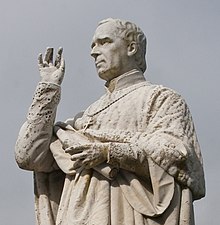John MacHale
|
The Most Reverend John MacHale |
|
|---|---|
| Archbishop of Tuam | |

Sculpture of John MacHale by Sir Thomas Farrell (1827–1900) at the site of Tuam Cathedral. The cathedral was completed on 18 August 1837 during his archbishopric.
|
|
| Native name | Irish: Seán Mac Éil |
| Church | Roman Catholic Church |
| Archdiocese | Tuam |
| Orders | |
| Ordination | 1814 by Daniel Murray |
| Consecration | 1825 by Pope Leo XII |
| Personal details | |
| Born |
6 March 1791 Tubbernavine, County Mayo, Ireland |
| Died | 7 November 1881 (aged 90) Tuam, County Galway, |
| Nationality | Irish |
| Denomination | Roman Catholic |
|
Styles of John MacHale |
|
|---|---|
 |
|
| Reference style | The Most Reverend |
| Spoken style | Your Grace or Archbishop |
John MacHale (Irish: Seán Mac Éil; 6 March 1789 in Tubbernavine, County Mayo, Ireland – 7 November 1881 in Tuam, County Galway, Ireland) was the Irish Roman Catholic Archbishop of Tuam, and Irish nationalist.
He laboured and wrote to secure Catholic Emancipation, legislative independence, justice for tenants and the poor, and vigorously assailed the proselytizers and the government's proposal for a mix-faith national school system. He preached regularly to his flock in Irish and ‘almost alone among the Bishops he advocated the use of Irish by the Catholic clergy.’
John MacHale was born in Tubbernavine, County Mayo, Ireland. Bernard O'Reilly places the date in the spring of 1791, while others suggest 1789 more likely. His parents were Patrick and Mary Mulkieran MacHale. He was so feeble at birth that he was baptised at home by Father Andrew Conry, who later was hanged during the Irish Rebellion of 1798. His father, known locally as Pádraig Mór, was a farmer, whose house served as a wayside inn on the highroad between Sligo and Castlebar. Although Irish was always spoken by the peasants at that time, the MacHale children were all taught English. John's grandmother, however, encouraged him to retain his knowledge of Irish.
By the time he was five years of age, he began attending a hedge school. Three important events happened during John's childhood: the Irish Rebellion of 1798; the landing at Killala of French troops, whom the boy, hidden in a stacked sheaf of flax, watched marching through a mountain pass to Castlebar; and a few months later the brutal execution of Father Conroy on a false charge of high treason. These occurrences made an indelible impression upon him. After school hours he studied Irish history, under the guidance of an old scholar in the neighbourhood. Being destined for the priesthood, at the age of thirteen, the boy was sent to a school at Castlebar to learn Latin, Greek, and English grammar. In his sixteenth year the Bishop of Killala gave him a busarship at St Patrick's College, Maynooth at Maynooth.
...
Wikipedia
